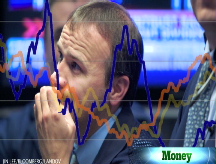Why blue chips will bounce back
The fundamentals of U.S. large-caps are strong, and market psychology will change - eventually
 |
| Pat Dorsey is the director of equity research for Morningstar. |
| MMA | 0.69% |
| $10K MMA | 0.42% |
| 6 month CD | 0.94% |
| 1 yr CD | 1.49% |
| 5 yr CD | 1.93% |
(Money Magazine) -- For many years, investors took it on faith that a portfolio of big blue-chip stocks - chockfull of familiar names like General Electric (GE, Fortune 500) and Coca-Cola (KO, Fortune 500) - was the surest path to investing success.
Why get cute with complicated stuff like foreign equities or small-cap shares when you could invest in well-known, industry-leading companies, sleep well at night and watch your portfolio steadily grow?
Obviously, that faith has been shaken recently because blue-chip shares just haven't appreciated. Over the past decade, Standard & Poor's 500 index has returned a mere 3.7% a year. You'd have to go back to the end of the 1970s bear market - or to the late 30s, as the Great Depression was winding down - to find a worse 10-year stretch for blue-chip stocks.
Is it time to throw in the towel on these once heralded shares? I don't think so because the reason they're struggling has nothing to do with declining American competitiveness or the dawn of the "Asian century," to name a couple of theories. It has to do with a short-term change in investors' mood, which won't last forever.
I think of investing in simple terms. When companies do well, so should their shares - eventually. And when businesses suffer, the stocks will too. Eventually.
In my view, there are really only three drivers of equity market returns:
You can make money based on a company's growing earnings, which will ultimately be reflected in its share price. You can make money if the company pays out a portion of its profits directly to you in the form of cash dividends. And you can make money if the market decides, for whatever reason, that it is willing to pay more for those earnings than in the past.
Of course, this also means you could lose money if investors don't want to pay that much for profits anymore. This last variable, called valuations, is the x factor at work here.
In the long run, it is a company's profit growth and dividends - which Vanguard founder John Bogle describes as your investment returns - that matter most. In fact, Bogle analyzed stocks in the 20th century and found that 9.8 percentage points of their 10.4% annual returns were because of earnings and dividends.
But while investment returns are key over time, a drop in valuations can significantly cut into your gains in the short term, as you've no doubt discovered.
Over the past decade, for example, the S&P's annual investment returns were a respectable 6.8%. But the market's price/earnings ratio, a key measure of valuations, fell from a frothy 29 to 21.
This change - which Bogle refers to as speculative returns - effectively reduced blue-hip stock performance by 3.1 percentage points a year. By contrast, in the prior 10 years, P/Es shot up from 12 to 29, adding to your investment gains.
Why do P/E ratios change so much? Interest rates certainly play a part, but the big reason is that there are simply times when people get more or less excited about owning a particular group of stocks.
Can I predict with certainty when this momentum will change? No. But history tells us that at some point enthusiasm becomes euphoria, or negativity becomes depression - and the cycle reverses.
In the meantime, think of it this way: You're taking far less risk buying blue chips at 21 times earnings - or lower - than you were at 29 times earnings in 1998. The fact is, there is a lot of value among U.S. large-caps right now, which you won't see by looking solely at stock charts.
Take General Electric (GE, Fortune 500), arguably the bluest of blue chips. Over more than a decade, GE has increased earnings per share 10.4% annually, with an average dividend yield of about 2.2%. But the stock has returned only about 2.5% annually as its P/E plunged from a lofty 36 in 1998 to 13.
There's a vocal contingent on Wall Street that assumes if the stock hasn't done well, there must be something wrong with GE. The reality is, GE's shares have stunk because they were just so expensive in 1998.
In contrast to the stock, GE the company has been performing rather well. Earnings have increased at a nice clip over the past decade, and profit margins are substantially higher. Add in a healthy 4% yield and the shares look quite attractive.
Ultimately, that's what makes a stock appealing - profits and dividends, not the mere fact that a stock's price happens to be rising at the moment.
Have you recently been hit up by a family member for a loan? Money wants to hear about it. Email us at makeover@moneymail.com, including who the person was, how much they needed, what they needed it for, and how you handled it. Please send along a recent photo, as well as your location and income. ![]()



